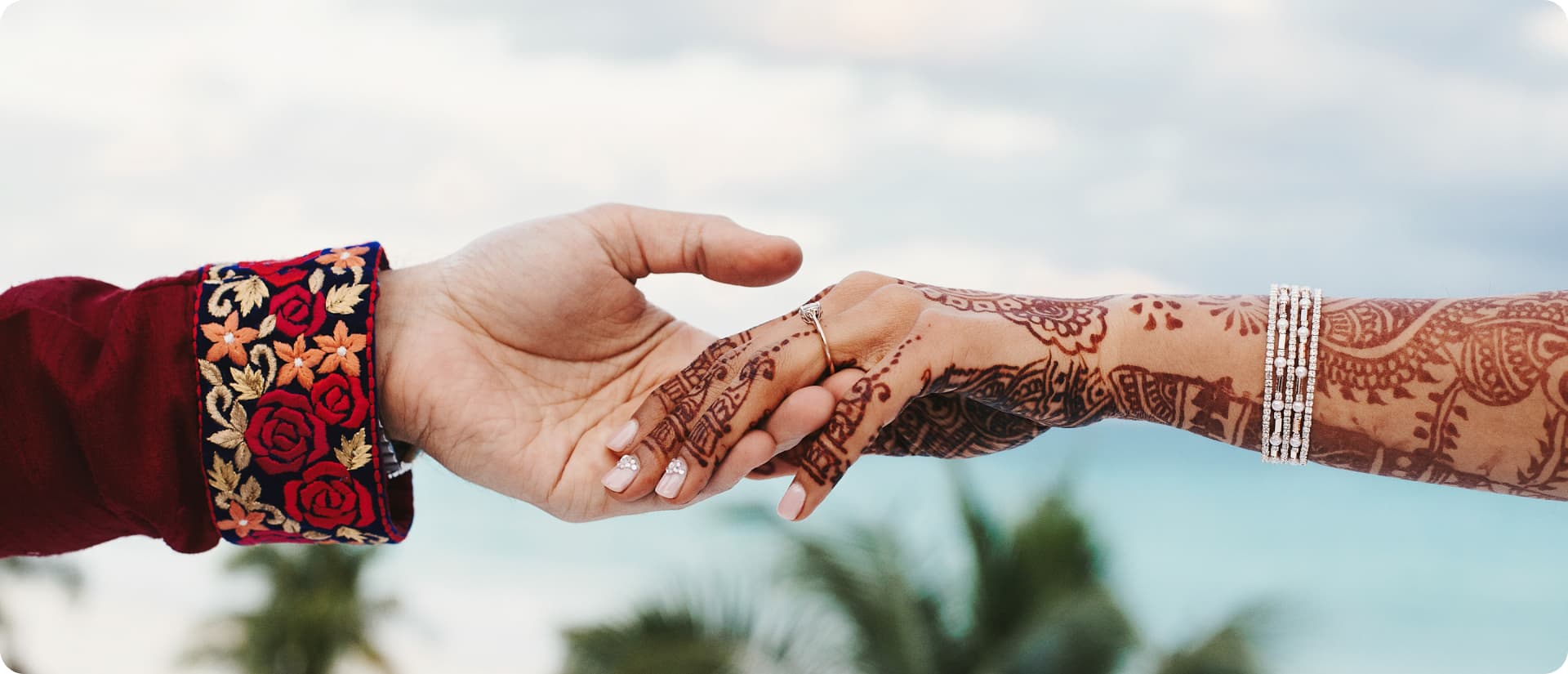Hindu wedding functions are a perfect representation of culture, traditions, love, and harmony among family members. The ceremonies, making up for a Hindu wedding, last for approximately 3-4 days, and it is a lot of fun.
Each custom and practice in a Hindu wedding ceremony holds philosophical and spiritual importance. Unlike Western wedding concepts, the consent and satisfaction of families are considered crucial in Hindu culture, as marriage is seen not only as a union of two people but also their families.
If you are planning your Hindu wedding and need some help, you have come to the perfect place. From the pre-wedding rituals like engagements to wedding customs like Pheras or Saptapadi, here is all you need to know about Hindu wedding rituals step by step.
Pre Wedding Ceremonies
Engagement
This is seen as one of the most important pre-wedding ceremonies, not only in Hindu culture but in many other religions as well. The engagement is often hosted as an intimate function with close friends and relatives from the bride’s and groom’s side.
Engagements are held a few months before the wedding, and the fathers of both the bride and the groom make a formal announcement of the marriage arrangement to their guests. Following this, the Hindu bride and the groom exchange rings to confirm their engagement. This replicates the ritual of Saptapadi or Phera done during the wedding ceremony, which symbolizes the journey of life in which the couple should travel together hand in hand.
Mehendi Ceremony
When following Hindu wedding rituals step-by-step, Mehendi is the first official function that starts the wedding season. It is an event where the bride applies henna to her hands and feet as a way of beautifying herself for her wedding. The Mehendi ceremony is often hosted alongside a lot of music and dancing by family members and friends.
While the bride will have to sit for hours to get her Mehendi art done, many of the female guests, including the bride’s friends, also get Mehendi done, at least in one of their hands. This shows as a sign of females participating in an auspicious wedding event.
Sangeet Ceremony
This is one of the most fun ceremonies families enjoy when attending Hindu wedding events. Some have sangeet as part of the engagement, but in recent times, it has become an individual function, extending the fun of the wedding season.
This is a function that helps both families hosting the wedding to forget about the wedding jitters for some time and truly enjoy the wedding season. Nowadays, many choose special themes for this event and dance performances are prepared by cousins, friends, and other close relatives to make the event more fun.
Haldi Ceremony
When it comes to understanding Hindu wedding rituals, it is important to acknowledge that these rituals can be addressed through other names in different parts of the country. For example, in Tamil and Kannada wedding rituals, the haldi ceremony is called mangala snanam. Generally, in the Haldi ceremony, a paste of haldi (turmeric) is applied to the bride and the groom’s body the day before or on the morning of their wedding.
Even the mixture used in the ceremony is known by different names according to regions, like mandha, ubtan, tel baan, etc. The ceremony is directly focused on beautifying the bride, as yellow is considered an auspicious colour and is believed to ward off evil eyes.
The Wedding
During the main event of the wedding, the couple exchanges varmalas and then takes seven Pheras, also known as Saptapadi. This is an important part of following Hindu wedding rituals step-by-step, as it is a form of making the wedding official in front of the priest while taking blessings from the elders.
During the Phera or Saptapadi ritual, the couple takes 7 steps, also known as 7 vows, to symbolize the bride and the groom’s commitment to the marriage. The 7 vows are as follows:
- Nourish each other
- Be each other’s strength
- Stay faithful
- Love each other’s families
- Care for Children
- Live a peaceful life together
- Maintain the bond of friendship
Traditionally, the wedding is hosted by the bride’s parents, and the groom and his family are their guests at the ceremony. A Hindu wedding ceremony, in simple terms, portrays the initial meeting between the bride and the groom in a wedding hall (Mandap). It is the main religious event where the bride’s parents give away the daughter to the engaged man and seek blessings from the guests invited to the ceremony.

Post Wedding Ceremonies
Vidaai
This is an emotional ceremony where the bride leaves her parent’s house and throws back five handfuls of rice over her head to reflect wealth and prosperity. As she leaves, the bride’s brothers and cousins push the vehicle as a way of symbolizing that they are helping the sister start a new phase in life with her husband.
Once the car starts, money is thrown on the road as a way of warding off evil spirits and eyes. This post-wedding ceremony is referred to using different names in different parts of the country, but the concept behind it remains the same and is considered a very important ritual in Hindu weddings.
Reception
As with many other Western cultures, this is a ceremony that is done to introduce the bride to the groom’s side of the family and their community. Traditionally, this ceremony has no rituals or customs. Different states like to celebrate or host this ceremony in their own ways.
Part of the celebration includes speeches and friends singing by dedicating songs and performing routines/games for the couple. Sometimes, following this, a huge sit-down dinner and a dance party will take place. More or less, this post-wedding ceremony follows the same theme as Western wedding receptions.
As you can understand, Hindu weddings are not just about a series of ceremonies but a deeply spiritual and culturally significant union of two compatible people. Every ritual in a Hindu wedding carries a sacred meaning and importance and is considered a celebration of unity, faith, love, and blessings.



